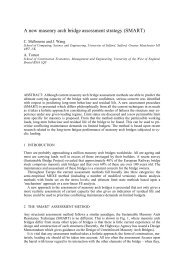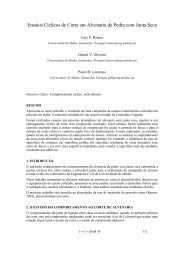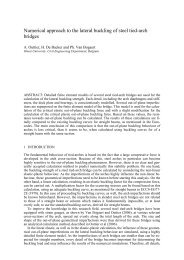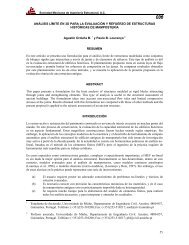164 ARCH’07 – 5th International Conference on Arch Bridgesinterpreted more or less appropriately. Also the data on the height <strong>of</strong> water during the <strong>flood</strong>culmination are usually well documented in situ on different types <strong>of</strong> high water line records.Table 1. Review <strong>of</strong> the oldest European medieval <strong>stone</strong> <strong>arch</strong> <strong>bridges</strong> (Velflík, 1921)City Years <strong>of</strong> Number Comments on technical features <strong>and</strong> <strong>flood</strong> damagesconstruction <strong>of</strong> <strong>arch</strong>esToledo 996 2Albi 1035-1178 7Palermo 1113 5Dresden 1119-1206 16Würzburg 1133 The bridge was heavily destroyed during 1342 <strong>flood</strong>.Regensburg 1135-1146 15 The 336 m long bridge has never been substantiallydestroyed by high water, even though a massive ice block<strong>and</strong> <strong>flood</strong> in 1784 destroyed two timber <strong>bridges</strong> repairingdamaged (built in 1633) or missing (built in 1499/1502) parts<strong>of</strong> the bridge.Prague 1169-1171 23 The bridge had in the river 12 <strong>arch</strong>es <strong>of</strong> span between 12,3 –19,8 m. It was severely damaged during 1342 <strong>flood</strong>Avignon 1177-1188Figure 1: Historic high water line scale in Limburg (Germany) on the Lahn River. (Photo T.Drdácký)Let us illustrate a typical life <strong>of</strong> a medieval bridge by several <strong>historic</strong>al examples. An ancientbridge in Prague across Vltava (Moldau) river was built from timber (?in 795?) <strong>and</strong> it wasdestroyed by <strong>flood</strong> several times: in the 9 th Century, in 935? (929?) “when the body <strong>of</strong> St.Wenceslas was transported across it” (Cristiane chronicle), in 1118 due to high water about 3me above the bridge deck (Cosmas chronicle) <strong>and</strong> lastly in 1159, (then a <strong>stone</strong> masonry bridgewas built by the Queen Judith).The Queen Judith’s bridge in Prague successfully survived heavy <strong>flood</strong>s in 1180, 1257, 1259,1264, 1273, 1311, 1315, 1316 <strong>and</strong> 1322 probably with minor damages only. But the high wateron the 12 th M<strong>arch</strong> 1272 with a lot <strong>of</strong> ice broke through the bridge in the middle <strong>of</strong> the riverMoldau (Dobner). The damage had been so large that the bridge “managers” – the Knights <strong>of</strong>the Cross (Hospitaliers) monastery – had to collect a special tax approved by the King PřemyslOtakar II. throughout the kingdom, (Tomek, 1855). Eventually, an ultimately destroying <strong>flood</strong>had happened in night on the 3 rd February 1342 when a large mass <strong>of</strong> ice had caused a collapse<strong>of</strong> about two thirds <strong>of</strong> the bridge that then never had been repaired <strong>and</strong> replaced later by thefamous Charles Bridge.The second oldest Bohemian bridge in Písek was built about the year 1265. Even though thebridge had been attacked several times with severe <strong>flood</strong>s his six from seven originally erected
M.F. Drdácký <strong>and</strong> Z. Slížková 165piers <strong>and</strong> <strong>arch</strong>es never collapsed. The 1342 disastrous <strong>flood</strong> destroyed the sp<strong>and</strong>rel walls the top<strong>of</strong> which reached 5,5 meters above the normal water level. In February, 22 nd 1768 ice floespartly destroyed cutwaters <strong>of</strong> three piers during a splash <strong>flood</strong> <strong>and</strong> one l<strong>and</strong> pier with theadjacent vault collapsed. Few years later, 27 th February 1784 two central piers were heavilydamaged <strong>and</strong> undermined. Two other significant high water events in 1845 <strong>and</strong> 1890 whenwater entirely filled the pr<strong>of</strong>ile <strong>of</strong> <strong>arch</strong>es did not cause major damage.The Charles bridge in Prague, (in the row <strong>of</strong> large medieval <strong>bridges</strong> being the fourth inBohemia <strong>and</strong> the thirty first in Europe), was founded on July 9 th 1357. Even the partially builtbridge was damaged by large <strong>flood</strong>s in 1359, 1367, 1370, 1373 <strong>and</strong> 1374. The most seriousdamage was caused by a catastrophic <strong>flood</strong> in 1432 (21 st July) when the huge mass <strong>of</strong> floatingmaterial blocked all bridge <strong>arch</strong>es with hay, timber <strong>and</strong> even wooden houses. The created damobstructed free flow <strong>of</strong> water which substantially elevated the high water line <strong>and</strong> contributed todestructive undermining <strong>of</strong> five piers with a subsequent collapse. The damage increased another<strong>flood</strong> in January 28 th 1496 when further pier with two adjacent <strong>arch</strong>es had failed which wasrepairing till 1503. After another heavy damage in 1655 three bridge piers had to be partlyrebuilt as a consequence <strong>of</strong> a strong <strong>flood</strong> on 28 th February 1784, Figure 2. The last partialcollapse <strong>of</strong> the Charles Bridge occurred in 1890 when again a huge amount <strong>of</strong> timber blockedthe water way <strong>and</strong> after undermining <strong>of</strong> two other piers the bridge <strong>arch</strong>es fell into water on threeplaces. Thus only one pier <strong>and</strong> one <strong>arch</strong> from the original medieval Charles bridge structurehave remained after the above mentioned damages <strong>and</strong> failures.From these examples it follows that <strong>flood</strong>ing is a natural <strong>and</strong> quite frequent loading situationfor <strong>historic</strong> <strong>stone</strong> <strong>arch</strong> <strong>bridges</strong>. A detailed evaluation <strong>of</strong> the Lahn River water gauge shows thatin the years 1255-1984 the <strong>bridges</strong> suffered 60 <strong>flood</strong>s, 22 <strong>of</strong> them major, i.e. in average a <strong>flood</strong>in every 12 years. Naturally, the major <strong>and</strong> namely catastrophic <strong>flood</strong>s represent exceptionalloads for such <strong>bridges</strong> with specific features <strong>and</strong> a strongly destroying action.The large <strong>stone</strong> <strong>bridges</strong> mostly sustained the static as well as dynamic pressure loads <strong>of</strong> waterprovided they were not combined with other loads (ice, timber) or with occurrence <strong>of</strong> dams <strong>and</strong>barriers piled up from floating material, which changed the water flow <strong>and</strong> caused problems t<strong>of</strong>oundations. Small, usually timber or improperly maintained <strong>bridges</strong> inclined to collapse totally,which has been referred to in several cases. For example, the <strong>flood</strong> on Curych Lake in 1778(July 8 th ) caused besides 63 fatalities also a total destruction <strong>of</strong> 15 houses <strong>and</strong> 8 <strong>bridges</strong>,(Swissworld, 2007)However, the modern time changed the <strong>flood</strong> loads compared to the <strong>historic</strong> ones. First, thereis practically no timber floating in large amounts in the rivers because <strong>of</strong> stopping the transport<strong>and</strong> water treatment <strong>of</strong> logs in rafts. Also the ice does not represent so high hazard as before dueto increased temperature <strong>of</strong> water in most rivers, <strong>and</strong> thanks to a better control <strong>and</strong> tools forearly removal <strong>of</strong> cumulating barriers. On the other h<strong>and</strong>, the floating cottages <strong>and</strong> garden housesare usual, <strong>and</strong> during the 2002 <strong>flood</strong> there occurred also lorries, containers <strong>and</strong> steel boats whichall have a quite high mass <strong>and</strong> energy at impacting into a <strong>historic</strong> bridge, Fig.2. Further, thewater has a higher chemical contamination which creates specific conditions for chemicaldegradation <strong>and</strong> biological attacks.Figure 2: Floating lorry <strong>and</strong> a container at a foot bridge in Prague – Troja during the <strong>flood</strong> in 2002.



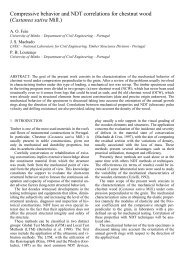
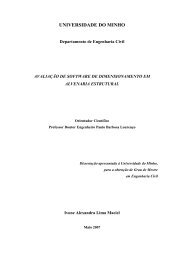
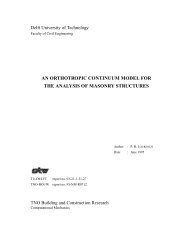

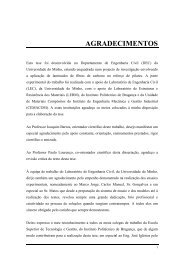

![Weibull [Compatibility Mode]](https://img.yumpu.com/48296360/1/190x134/weibull-compatibility-mode.jpg?quality=85)

